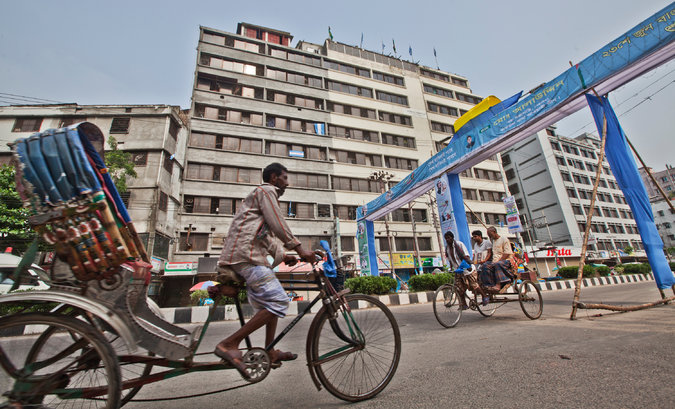Eight times now, the European-dominated Accord on Fire and Building Safety in Bangladesh — a group of more than 150 retailers and brands — has forced the temporary closing of garment factories after its inspectors found dangerous conditions.
But from the time the inspections began, tensions have been growing between the Accord and the Bangladeshi apparel industry, resulting in an impasse over a recent attempt to shutter what the Accord considers an unsafe factory building that houses Florence Fashions. And this time, as on several previous occasions, the Bangladeshi government has aligned with a garment manufacturer opposed to having its factory closed, even temporarily.
The series of inspections through more than 1,000 of the country’s apparel factories has been emotionally freighted from the start, with workers, manufacturers, building owners and government officials watching the process with conflicting sentiments.
Of course, many Bangladeshis recognize the need for these inspections, and for some dangerous factories to be closed, as part of a broad-based effort to prevent another disaster like the Rana Plaza building collapse that killed 1,129 workers in April 2013.

But factory closings can have immediate economic impact. Some factory owners worry about losing large and profitable orders to other companies and countries, and garment workers themselves fear losing their jobs. In one of the first closings after an Accord inspection, workers took to the streets in a raucous demonstration, protesting that their wages might not be paid.
Created a little more than a year ago to ensure worker safety in Bangladesh, the Accord has moved at a steady pace with inspections. It has hired 110 engineers and inspected 775 factories for structural soundness, unsafe electrical boxes, adequate fire exits and sprinkler systems — a new requirement for factory buildings 75 feet or taller.
Somewhat paralleling the Accord, two dozen American and Canadian companies, including Walmart and Gap, have formed the Alliance for Bangladesh Worker Safety. That group has inspected 601 factories, and has had five of them fully or partly closed because of the safety problems found, its officials say.
But in numerous cases where hazardous conditions were uncovered, the groups have confronted considerable resistance to closing a factory building altogether, and to the notion that a building should be closed as soon as possible.
In the case that has caused friction these last several months, a 10-story building in Dhaka containing Florence Fashions houses five factories, two of which produce garments for retailers that belong to the Accord: Florence, with 800 employees, and Cherry Private Limited.
Engineers at the Accord originally called for the factories in the building to be closed after they inspected Cherry — and Cherry’s managers quickly agreed to close until recommended safety improvements were made.
But Florence declined to close, although it complied with the Accord’s request to cease making goods produced there for any Accord member — like Mavi, a Turkish company. Florence has continued production for other, non-Accord buyers.
Rob Wayss, the Accord’s executive director for Bangladesh, said his group — which includes H&M, Carrefour and many other prominent companies — has been trying to get the factory closed since an inspection in March.
The engineers “determined that in its current state, the building wasn’t safe for people to be in,” Mr. Wayss said.

Brad Loewen, the chief inspector for the Accord, put it in more dire terms, saying that he feared a collapse could occur. “The exact safety problem was too much weight, too much of a load, on the support columns,” he said.
But Florence’s director, Mohammad Monirul Islam, said in an interview that the Accord had never formally presented his company with papers specifying what safety problems were uncovered.
“The Accord told us to shut down the factory instantly without giving any solution,” Mr. Islam said in an interview this week at his factory. “The Accord did not give us any report after inspecting our factory. They did not give us any notice after the inspection.”
Accord officials said they had met face-to-face with Florence’s executives and sent them emails describing the problems. Mr. Islam said factories in the building had removed their storage loads after inspectors said the loads needed to be reduced immediately.
“When there’s a structural inspection, when the building is found to be unsafe, it’s unsafe for everyone in the building,” Mr. Wayss said. “The building should be evacuated for everyone.”
The Accord called on a Bangladeshi government review panel to confirm its recommendation that Florence Fashions be closed, but Accord officials said the government declined to order a shutdown even though the panel agreed with the findings.
In an interview, Syed Ahmed, the inspector general for Bangladesh’s Department of Inspection for Factories and Establishments, said his department had not received the proper request and records from the Accord to justify closing Florence.
Mr. Ahmed said he learned about the Accord’s desire to close Florence only from the Accord’s website. He said the safety findings detailed on the site were not official or binding on him.
Mr. Loewen, the Accord’s chief inspector, said his group’s engineers had met with Mr. Ahmed and managers of the factories in the building — and later wrote to them — about urgent safety problems after the initial inspection of the Cherry factory.

“As far as they’re saying they were never informed, the inspector general and Florence were at the table right from the get-go,” Mr. Loewen said. “They’re being a little cute.”
Mr. Wayss, the executive director, added, “It doesn’t seem quite honest for them to say they don’t know what’s happening.”
In the months since the inspections started, some factory owners and government officials have grown resentful of the Accord’s methods and accused the group’s officials and engineers of being highhanded and seeking to dictate to them. But the government, under agreements with the Accord, is supposed to order any factories closed where conditions have been deemed unsafe by engineers and confirmed by a review panel.
The Accord, unlike the Alliance, has some large labor federations and nongovernment organizations as members, and the Accord has often taken a tougher stance toward the government and the Bangladeshi garment manufacturers. The Accord recently tussled with the government over the strength required for concrete support pillars. Some Accord board members say the Bangladeshi garment industry has had too much sway over the government; for years, the industry fought against rigorous government regulations or inspections.
Worsening tensions, the Bangladeshi commerce minister and the head of the Bangladesh Garment Manufacturers and Exporters Association accused Bangladeshi union leaders this week of undermining the nation’s image and garment industry by asserting that some labor leaders and pro-union workers have been tortured, beaten and harassed.
Atiqul Islam, president of the manufacturers’ association, said in a speech on Monday in Dhaka that the labor leaders’ complaints were subversive to the state, adding that the government should punish them.
The widening rift between the garment industry and labor comes as the Bangladeshi government and garment industry seek to persuade the Obama administration to restore trade preferences that were suspended last year because of concerns about serious safety problems and labor rights violations in the country’s garment industry.
The American-dominated Alliance has in many ways been operating on a similar track to the Accord. Ian Spaulding, a senior adviser to the Alliance, said “a tremendous amount of progress has been made.” The group has inspected 601 of the 611 factories used by its members, he said, so the Alliance would reach its goal of having all its factories inspected by July 10.
“The first phase of our work on inspections and safety training is behind us — that’s the easy part,” Mr. Spaulding said. “The hard part — remediation — is now in front of us, getting fire doors installed, getting fire sprinkler systems, increasing water capacity for fire suppression.”
The remediation process, garment industry experts say, could lead to clashes between the Bangladeshi factory owners and the Western brands about who should pay for needed safety improvements — especially because many factory owners are expected to say they cannot afford to make the repairs.
Source: NYTimes










